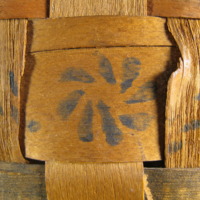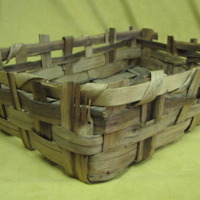Pre-Contact through mid 1800s
Native Americans in the Northeast have woven baskets and bags from plant materials for hundreds, perhaps thousands, of years. Fragments of wood splint baskets have been recovered in New York and Pennsylvania on archaeological sites dating as far back as the 1500s and 1600s.
Surviving splint baskets from the late-1700s through the mid-1800s were utilitarian containers used by both Native Americans and European colonists. Large baskets were used for storing clothes, hats and household goods. Interiors were rough and were often lined with newspaper to protect stored items. Smaller baskets were used as sewing baskets, fruit baskets and picnic baskets. They were often decorated by swabbing, stamping or painting natural pigments on the outside of individual splints.
Native Americans in the Northeast travelled door-to-door to sell these baskets to their non-Native neighbors. Non-Natives also travelled to Native encampments to purchase them. In nearby Hopkinton, New Hampshire residents purchased baskets from Native women who were living on the banks of the Contoocook River. - Mt. Kearsarge Indian Museum





